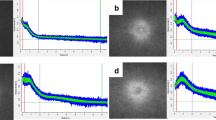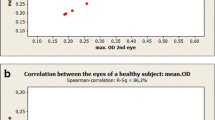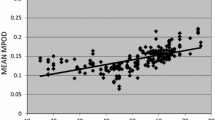Abstract
Background
Macular pigment (MP) reduces oxidative damage in the central retina and can be quantified by flicker-photometric analysis (HFP) of MP optical density. These analyses demonstrate a very good correlation with central absorption by MP on autofluorescence (AF) images. With these techniques different types of MP-distribution have been described. In the present study a quantification analysis of MP in AF images was developed to verify these MP types and to compare MP distribution patterns between healthy individuals and those with age-related macular degeneration (AMD).
Methods
AF images (HRA) were analysed with respect to the area of central and paracentral absorption in 400 eyes with a computerised analysis program of MP optical density. The patients were between 41 and 90 years old (mean 67.2 years); 168 were male and 232 female, and 253 had early AMD and 147 showed no AMD characteristics. The central MP concentrations (peak) were measured, the amount of MP values within the first 8-pixel radius (“C”), the total amount of MP within a 120-pixel radius (“T”) were calculated as the volume of the MP values over the regarded radius and the C/T ratio was registered.
Results
Four types of MP distribution (type 1, intense central and paracentral MP; type 2, less intense central and paracentral MP; type 3, only central MP; type 4, only paracentral MP) were identified. The differences in MP distribution were confirmed and clearly characterised by quantitative analyses of peak, total MP (“T”), central MP (“C”) and C/T ratio: mean peak in type 1, 0.65; type 2, 0.42; type 3, 0.42; type 4, 0.29; mean total amount of MP in 120-pixel radius (“T”) in type 1, 5829.0; type 2, 4412.5; type 3, 2709; type 4, 4302.8. MP types with lower levels of MP were significantly more often observed in the AMD group (AMD: type 1, 120=47.4%; types 2–4, 133=52.6%; healthy eyes: type 1, 112=76.2%; types 2–4, 35=23.8%) (P<0.0001)
Conclusions
Analysis of MP on AF images is a quantitative method for investigation of MP. With this method a wide variation in concentration and distribution of MP could be seen in the population. Four different types of MP distribution could be characterised and quantitatively distinguished. Reduced levels of MP seem to be associated with a higher risk of development of AMD as they were significantly more often observed in the AMD group. This strategy of quantitative MP analysis on AF images is easily practicable and may be used in further studies to investigate the role of MP as a potential risk factor for AMD.


Similar content being viewed by others
References
Beatty S, Boulton M, Henson D, Koh HH, Murray IJ (1999) Macular pigment and age related macular degeneration. Br J Ophthalmol 83:867–877
Beatty S, Koh H, Phil M, Henson D, Boulton M (2000) The role of oxidative stress in the pathogenesis of age-related macular degeneration. Surv Ophthalmol 45:115–134
Beatty S, Koh HH, Carden D, Murray IJ ( 2000) Macular pigment optical density measurement:a novel compact instrument . Ophthalmic Physiol Opt 20:105–111
Beatty S, Murray IJ, Henson DB, Carden D, Koh HH, Boulton ME (2001) Macular pigment and risk for age-related macular degeneration in subjects from a northern European population. Invest Ophthalmol Vis Sci 42:439–446
Berendschot TT, Willemse-Assink JJ,Bastiaanse M, de Jong PT, van Norren D (2002) Macular pigment and melanin in age-related maculopathy in a general population. Invest Ophthalmol Vis Sci 43:1928–1932
Berendschott TJ, van de Kraats J, van Norren D (2001) Wavelength dependence of the Stiles–Crawford effect explained by perception of backscattered light from the choroids.J Opt Soc Am A Opt Image Sci Vis 18:1445–51
Bird AC, Bressler NM, Bressler SB, Chisholm IH, Coscas G, Davis MD, de Jong PT, Klaver CC, Klein BE, Klein R, et al (1995) An international classification and grading system for age related maculopathy in age-related macular degeneration. Surv Ophthalmol 39:367–374
Bone RA, Landrum JT, Tarsis SL (1985) Preliminary identification of the human macular pigment. Vision Res 25:1531–1535
Bone RA, Landrum JT, Fernandez L (1988) Analysis of the macular pigment by HPLC: retinal distribution and age study. Invest Ophthalmol Vis Sci 29:843–849
Bone RA, Landrum JT, Friedes LM (1997) Distribution of lutein and zeaxanthin stereoisomers in the human retina. Exp Eye Res 64:211–218
Bone RA, Landrum JT, Mayne ST, Gomez CM, Tibor SE, Twaroska EE (2001) Macular pigment in donor eyes with and without AMD. A case-control study. Invest Ophthalmol Vis Sci 42:235–240
Ciulla TA,Curran-Celentano J, Cooper DA et al (2001) Macular pigment optical density in a midwestern sample. Ophthalmology 108:350–355
Curcio CA, Medeiros NE, Millican CL (1998) The Alabama Age-related Macular Degeneration Grading system for donor eyes Invest Ophthalmol Vis Sci 39:1085–1096
Delori FC, Goger DG, Hammond BR, Snodderley DM, Burns SA (2001) Macular pigment density measured by AF spectrometry: comparison with reflectometry and heterochromatic flicker photometry. J Opt Soc Am A 18:1212–1230
Eye Disease Case-Control Study Group (1993) Arch Ophthalmol 111:104–109
Hammond BR, Caruso-Avery M (2000) Macular pigment optical density in a southwestern sample. Invest Ophthalmol Vis Sci 41:1492–1497
Hammond BR, Fuld K (1992) Interocular differences in macular pigment density. Invest Ophthalmol Vis Sci 33:350–355
Hammond BR, Fuld K, Snodderly DM (1996) Iris colour and macular pigment optical density. Exp Eye Res 62:715–720
Hammond BR, Johnson EJ, Russell RM et al (1997) Dietary modification of human macular density. Invest Ophthalmol Vis Sci 38:1795–1801
Kirschfield K (1982) Carotenoid pigments: their possible role in protecting against photooxidation in eyes and photoreceptor cells. Proc R Soc Lond B 216:71–85
Klein R, Davis MD, Magli YL, Segal P,Klein BEK, Hubbard L (1991) The Wisconsin age-related maculopathy grading system. Ophthalmology 98:1128–1134
Landrum JT, Bone RA, Vidal I, Menendez E, Kilburn M (1995) Macular pigment stereomers in individual eyes: a comparison between normals and those with age-related macular degeneration. Invest Ophthalmol Vis Sci 36 [Suppl]: 857–863
Landrum JT,Bone RA,Kilburn MD (1997) The macular pigment—a possible role in protection from age related macular degeneration. Adv Pharmacol 38:537–556
Leung I, Tso M, Li W, Lam T (2001) Absorption and tissue distribution of zeaxanthin and lutein in rhesus monkeys after taking Fructus lycii (Gou Qi Zi) extract. Invest Ophthalmol Vis Sci 42:466–471
Lois N, Halfyard AS, Bird AC, Fitzke FW (2000) Quantitative evaluation of fundus autofluorescence imaged “in vivo” in eyes with retinal disease. Br J Ophthalmol 84:741–745
Moreland JD, Bhatt P (1984) Retinal distribution of retinal pigment. Doc Ophthalmol Proc Ser 39:127–132
Moreland JD, Robson AG, Soto-Leon N, Kulikowski JJ (1998) Macular pigment and the colour-specificity of visual evoked potentials. Vision Res 38:3241–3245
Nussbaum JJ, Pruett RC, Delori FC (1981) Macular yellow pigment. The first 200 years. Retina 1:296–310
Pauleikhoff D, van Kuijk FJGM, Alexander R, Luthert P, Bird AC (2002) Histological evaluation of localization and distribution of macular pigment in the human retina. Invest Ophthalmol Vis Sci [Suppl] S102
Pease PL, Adams AJ, Nuccio E (1987) Optical density of human macular pigment. Vision Res 27:705–710
Rapp LM, Maple SS, Choi JH (2000 ) Lutein and zeaxanthin concentrations in rod outer segment membranes from perifoveal and peripheral human retina.Invest Ophthalmol Vis Sci 41:1200–1209
Robson AG, Moreland JD, Pauleikhoff D, Morrissey T, Holder GE, Fitzke FW, C Bird A, van Kuijk FJ (2002) Macular pigment density and distribution: comparison of the fundus autofluorescence with minimum motion photometry. Vision Res 43:1765–75
Seddon JM, Ajani UA, Sperduto RD, Hiller R, Blair N, Burton TC, Farber MD, Gragoudas ES, Haller J, Miller DT, Yannuzzi LA, Willett W (1994) Dietary carotenoids, vitamins A, C, and E, and advanced age-related macular degeneration. Eye Disease Case-Control Study Group. J Am Med Assoc 272:1413–1420
Snodderly DM (1995) Evidence for protection against age-related macular degeneration by carotinoids and antioxidant vitamins. Am J Clin Nutr 62:1448–1461
Snodderly DM, Brown PK, Auran JD, Delori FC (1984) The macular pigment. I. Absorbance spectra, localisation and discrimination from other yellow pigments in primate retinas. Invest Ophthalmol Vis Sci 25:660–673
Snodderly DM, Handelmann GJ, Adler AJ (1991) Distribution of individual macular pigment carotenoids in central retina of macaque and squirrel monkeys. Invest Ophthalmol Vis Sci 32:268–279
Sommerburg O, Siems WG,Hurst JS, Lewis JW, Kliger DS, van Kuijk FGJM (1999) Lutein and Zeaxanthin are associated with photoreceptors in the human retina. Curr Eye Res 19:491–495
van Kuijk FJGM, Pelosini L, Patel J, Pauleikhoff D, Fitzke F, Bird AC:Grading of macular pigment phenotypes using autofluorescence imaging Invest Ophthalmol Vis Sci [Suppl] S102
Vienot F (1997) Effect of macular pigmentation and cone effective optical density on colour matches. XIVth Symposium IRGCVD, P25
Von Rückmann A, Fitzke FW, Bird AC (1995) Distribution of funds auto fluorescence with a scanning laser ophthalmoscope. Br J Ophthalmol 79:407–412
Von Rückmann A, Fitzke FW, Bird AC (1997) Fundus autofluorescence in age-related macular disease with a scanning laser ophthalmoscope. Invest Ophthalmol Vis Sci 38:478–486
Von Rückmann A, Fitzke FW, Bird AC (1999) Distribution of pigment epithelium auto fluorescence in retinal disease state recorded in vivo and its change over time. Graefes Arch Clin Exp Ophthalmol, 237:1-9
Author information
Authors and Affiliations
Corresponding author
Appendix: Analysis
Appendix: Analysis
Let F F (Λ,λ) and F P (Λ,λ) be the AF (Λ is the excitation wavelength, λ the emission wavelength) measured at the fovea and the perifovea, let D F and D P be the optical density of MP at both sites, and F* F (Λ,λ) and F* P (Λ,λ) be the fluorescence of all layers located posteriorly to the MP. We assume that all detected fluorescence has been affected by MP absorption and modify Delori’s formula as follows (as due to the broad band-pass barrier filter we measure all wavelengths from 500 to 720 nm that reach the detector, not just a single wavelength as used in recent studies [14] Furthermore, we consider the spectral responsivity S(λ) of the detector. Thus we can express the foveal and perifoveal fluorescence as:
Now we determine the logarithm of the quotient of Eq. 2 and Eq. 1:
Applying Beer’s law we get:
If we neglect the log term (\( F^{*}_{P} (\Lambda ,\lambda ) \approx F^{*}_{F} (\Lambda ,\lambda ) \) and D P (λ)≈0 and D F (λ)≈0 for most of the detected wavelengths) on the right side we get:
or
If we consider the extinction coefficient for Λ=488 nm we get:
Let C be the brightest spot on the image. Applying the rules of logarithm we can calculate:
This means we can calculate the optical density relatively to the brightest spot in each image. Then we have to subtract the optical density of the plateau from this value to get the optical density of the fovea relative to the plateau. First we determine the radial distribution of the optical density around the fovea. Since we want the location of the plateau to be variable, we normalise the optical densities to the brightest spot in the image and display it.
Now the plateau is marked. Using Eq. 8 we subtract the optical density of the plateau to get the values relative to the plateau. These values are evaluated, averaged, integrated and so on.
Rights and permissions
About this article
Cite this article
Trieschmann, M., Spital, G., Lommatzsch, A. et al. Macular pigment: quantitative analysis on autofluorescence images. Graefe's Arch Clin Exp Ophthalmol 241, 1006–1012 (2003). https://doi.org/10.1007/s00417-003-0796-4
Received:
Revised:
Accepted:
Published:
Issue Date:
DOI: https://doi.org/10.1007/s00417-003-0796-4




